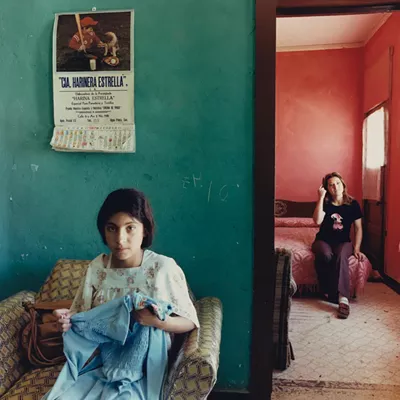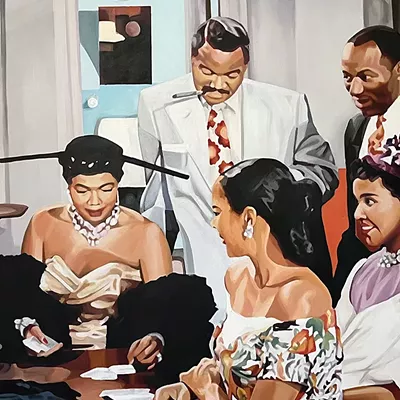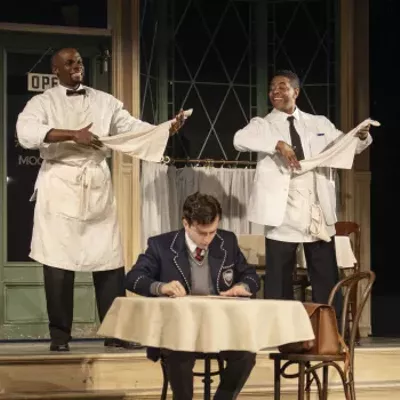"I need this dress," she said to herself, as she recounted the story last week. "It is so not me."
She snapped it up on the spot. The red vinyl dress, worn atop black tulle, found its way into a duet that Braun performed with her husband, the musician Arthur Miscione. That modern-dance piece, "She Will Never Love Me," features a red-bedecked Braun climbing all over an indifferent Miscione.
"It's light and funny," she says.
The duet not only will open a concert of Braun's choreography this weekend; it spawned another red vinyl work for 15, a big, red production number called, deadpan, "Red Vinyl."
Presented by ZUZI! Dance Company, the Stand and Be Counted concert will feature live music, 17 dancers from ZUZI and other local troupes, and seven dances old and new, ranging from the two fun red-vinyl works to three serious pieces about the Holocaust. In fact, the whole second half of the show is devoted to narrative Holocaust works, one about Anne Frank, another about Tucson Holocaust survivor Gabrielle Schneider, and a third, brand-new, about the Nazis' persecution of gay men.
"Something is compelling me to get these Holocaust stories out there," says Braun, a ZUZI member who says she feels "really connected" to her Judaism.
But when she was looking over the tentative program with dancer Nathan Dryden, she realized that "so many pieces are so serious. Nate looked at the red vinyl dress and said, "I have red vinyl pants. Let's do a whole red vinyl dance.'"
So Braun and Dryden collaborated on "Red Vinyl," a chorus number with choreographically strong connections to the original duet. Set to "Now I'm Your Man," from David Byrne's Talking Heads days, the piece is "fun dancing, lighthearted," Braun says, a nice counterbalance to the tragic works to come.
A native New Yorker, Braun first trained in classical ballet but switched to modern at SUNY Brockport, where she also got a master's in dance and choreography. In the early '90s she danced in New York with Joy Kellman and Randy James Danceworks (Tucson's NEW ART troupe danced a James pieces in its January show), and moved out to Tucson mid-decade. After working with both ORTS and 10th Street, Braun joined ZUZI in 1999.
In the last year, the two halves of Braun's professional life have gelled. She became head of the dance program at University/Rincon High School in the fall ("I feel like I'm in the right place," she says), and ZUZI proposed a show exclusively of her choreography. Delighted, Braun began assembling repertory pieces.
"I picked work for which I've gotten the most positive feedback," Braun says, "and that choreographically does what I intended."
Two dances, "Skyscraper" and "The Struggle," have been performed in Tucson several times, and re-worked.
"They're finished now," she says.
"The Struggle" was part of Journey, an evening-length concert of dance and music that Braun and Miscione produced on their own several years running. "Skyscraper" alludes to the lost towers of the World Trade Center.
Braun says she came to the Holocaust theme after seeing the large traveling Anne Frank exhibition at the Jewish Community Center in the late '90s. The documentary show also included numerous talks by local Holocaust survivors.
"I heard the survivors speak. That lit the spark back then."
Braun got a grant from the Jewish Arts Alliance and set to work on "Girl in the Window," the Anne Frank dance.
"I took excerpts from the diary to create the piece. Emily Willard plays the character reading from her diary, and there are three dancers: me, Wendy Joy and Yumi Shirai."
Miscione performs his own composition, "Moving," a "beautiful song that really moves people."
The next piece in the series, "Stand and Be Counted," tells the life tale of concentration camp survivor Schneider. Opening in the years before World War II, the dance is drawn from 20 stories Schneider wrote about her experiences under the Nazis. (Schneider's paintings on the same subject will be on view in the lobby.)
The dance is set to popular swing music of the '30s, as well as classical work by Yo-Yo Ma, and "eerie modern classical music" on strings performed by the Ahn Trio, three Japanese sisters.
The final Holocaust work, "Hidden Memories," is a brand-new piece, co-sponsored by Wingspan. A quartet for four men, "it's pretty heavy," Braun says. "The inspiration came from Paragraph 175, the name of the Nazi law that states that sex acts between men were illegal."
Braun says she watched a documentary about the Nazi persecution of gays that included interviews with about 10 gay survivors of the camps. Adding to the horror of the murders of gays, Braun notes, was the silence that ensued after the war.
"People did not want to hear what they went through," Braun says. "So they stayed silent. People didn't know about it."
Two of her high school students, Tyler Sislow and Steven Felix, join Greg Colburn and Dryden in the dance. Percussionist Michael Vercelli composed the music, which he'll perform along with Miscione on guitar and upright bass, singer Bob Ronstadt on accordion and piano and Michael Ronstadt on cello.
Nanette Robinson, ZUZI artistic director, will narrate all three Holocaust pieces, playing the adult child of a survivor. Braun wrote the text herself, based on interviews she did with Schneider's son and granddaughter. Braun now considers the Holocaust dances, strung together by the new narration, to be three parts of a single long work.
"There's something about this work that's so important to me," Braun says. "I'm getting such a clear understanding that these survivors are going to be gone soon. My message is that I need to put this out there."










